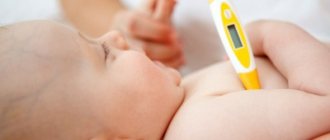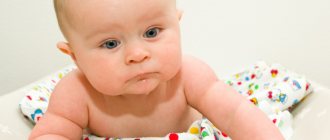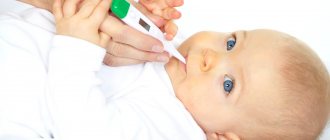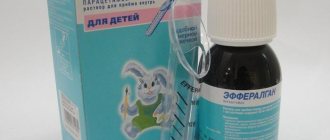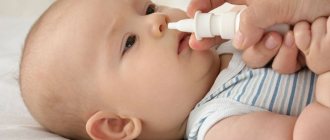04/15/2020 436 Pediatrics
Author: Elena
The temperature of a newborn is unstable and requires regular monitoring. Until three months of age, minor jumps are normal. Significant fluctuations occur due to illness and reactions to external factors, so for accurate indicators it is important to correctly measure the baby’s temperature.
[Hide]
What determines a baby's body temperature?
The temperature range of a newborn baby may fluctuate depending on exposure factors and internal processes. The optimal deviations are no more than one and a half to two degrees.
Temperature fluctuations can be affected by:
- time of day (increases are possible in the evening, vice versa in the morning);
- excessive physical activity;
- cry;
- teething;
- infection (viral/bacterial);
- food;
- graft;
- emotional component.
The child's temperature should be measured in a calm state. During meals or during periods of overexcitement, the readings are higher than normal.
What thermometer indicators are optimal?
Stability of temperature indicators is established at the age of two to three months. The measurement results differ depending on the method of the procedure, since parts of the body have different temperatures.
| Way | Indicators |
| in the armpit | 36,3 – 37,3 |
| in the mouth | 37,1 |
| in the rectum | 37,6 – 38 |
| in the ear | 31,3 |
How to measure a child's temperature?
How to measure the temperature of a newborn? Let's look at different ways to measure temperature in children.
Temperature measurement step by step
It is advisable that the baby has his own personal thermometer . Before each use, wipe it with alcohol or warm water and soap. Temperature can be measured in the rectum, mouth, armpit or groin.
Oral temperature measurement
This method is very common in English-speaking countries and is quite reliable. When measuring oral temperature, the thermometer reservoir is placed between the undersurface of the tongue and the floor of the mouth. The patient holds the thermometer body with his lips. However, it is contraindicated for children under 4-5 years of age and children with increased excitability.
Rectal temperature measurement
Measuring the temperature in the rectum has long been considered the standard for temperature measurement, but has always been accompanied by discomfort. This makes it convenient to measure the temperature of only the youngest children. At the age of six months, the baby will deftly wriggle out and will not allow you to do this. Moreover, this method is not safe. The mucous membranes of babies are very delicate and can be easily damaged. When measuring temperature with a mercury thermometer, careless movement by a child can cause the thermometer to break while in the butt.
An electronic thermometer is better suited for measuring rectal temperature, as it allows you to take the measurement very quickly: you will get the result in less than 1 minute.
✓ So, take a thermometer (first shake off the mercury to below 36.0 °C), lubricate its tip with baby cream.
✓ Place the baby on his back, lift his legs with one hand (as if you were washing him), with the other hand carefully insert the thermometer into the anus so that its tip “sinks” into it (about 2 cm). Fix the thermometer with two fingers, and with the remaining fingers squeeze the baby’s buttocks.
Measuring armpit temperature
✓ Shake the mercury thermometer to a level below 36.0 °C. Dry the skin under your armpit or in the groin fold, as moisture cools the mercury.
✓ To measure the temperature in the groin, lay the baby on his side (if you are taking measurements under the arm, sit him on your lap or pick him up and walk around the room with him). Place the thermometer so that the tip is entirely located in the skin fold, then press the baby’s leg (arm) to the body with your hand.
Temperature measurement in the outer ear canal
This measurement of body temperature is carried out ONLY with a specially designed electronic thermometer; its sensor is inserted into the external auditory canal. The device measures the temperature within 1-2 seconds.
By slightly pulling the ear up and back (for a child under one year of age - down and back), you should try to straighten the ear canal so that the eardrum becomes visible. Then you need to insert the thermometer probe into your ear.
Limits of normal temperature measured in different places
| In the oral cavity | 36.5-37.5 oC |
| In the armpit and inguinal fold | 36.0-37.0 oC |
| In the rectum | 37.0-38.0 oC |
| In the external auditory canal | 36.8-37.8 oC |
Useful tips and interesting information
➠ Babies’ oral temperature can only be measured using a pacifier thermometer.
➠ In 2007, the European Union banned the sale of thermometers containing mercury. The veto was imposed on mercury thermometers for measuring body temperature, as well as room thermometers, barometers and devices for measuring blood pressure.
➠ This was done in order to preserve the health of citizens (inhalation of mercury vapor from a broken thermometer can lead to severe poisoning, affecting the lungs, kidneys and brain) and protect the environment (reduce the amount of toxic mercury released into the environment with garbage).
➠ Due to its fragility, a mercury thermometer cannot be used to measure a child’s body temperature in the mouth! If the thermometer accidentally breaks and mercury spills, collect it with a syringe (rubber bulb). The syringe should then be sealed in a bag and thrown away. Under no circumstances should you collect mercury with your hands or a rag. After collecting mercury, the room must be ventilated and the floor thoroughly washed.
Similar articles:
How to choose the right thermometer for a child
Types of thermometers (thermometers)
Several types of thermometers are used to measure temperature indicators:
- mercury;
- electronic;
- infrared;
- pacifier thermometer;
- disposable.
Mercury thermometer
A mercury thermometer is used to measure temperature in the classic way - in the armpit. It is also possible to measure in the rectum.
Among the positive characteristics noted:
- versatility;
- accuracy in measurements (error of 0.1 degrees);
- convenience of the distribution scale.
Disadvantages of a mercury thermometer:
- the presence of mercury, a dangerous component;
- glass shell, requiring careful use;
- long measurement time - 5 - 7 minutes, which is not easy for a fidgety baby.

Electronic
An electronic thermometer measures the temperature rectally, also in the armpit, mouth and ear. This is a modern device for quickly measuring temperature indicators, suitable for a small child.
Advantages of the device:
- measurement time - three minutes;
- easy to use;
- safe;
- sound signal of the end of the measurement.
Among the shortcomings, only one is noted - the inaccuracy of the indicators reaches one degree.
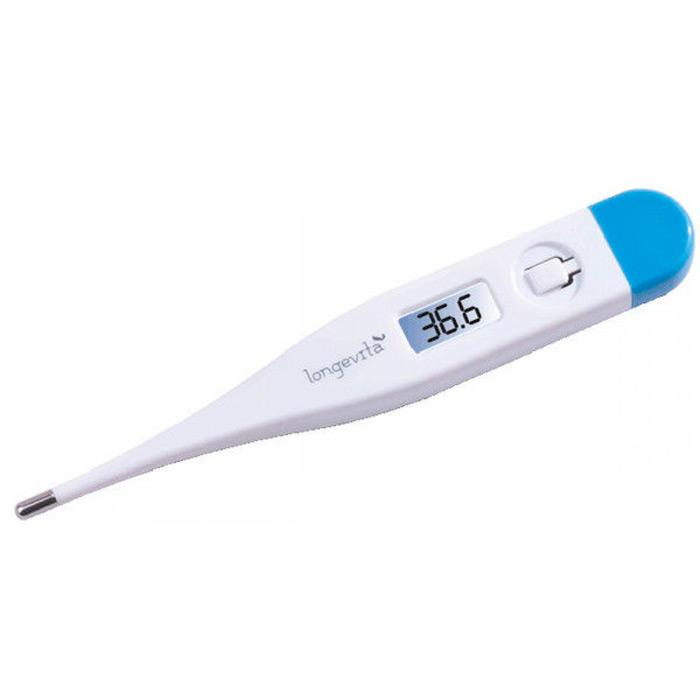
Infrared thermometer
There are two types of infrared thermometer:
- ear;
- contactless.
The ear detects body temperature in a couple of seconds. Good to use when baby is sleeping. Non-contact detects degrees without direct contact. It immediately gives results when it is brought to the forehead or temples.
The only disadvantage of any model of infrared thermometer is the high price.
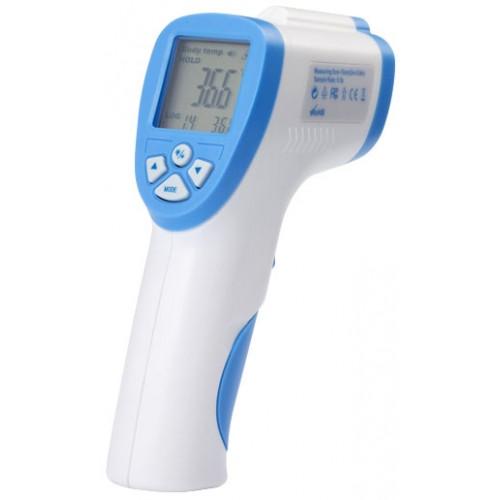
Pacifier thermometer
Outwardly, it is no different from a pacifier. A special electronic dial shows temperature readings.
Positive characteristics:
- since it looks like a pacifier, it does not frighten the baby;
- The measurement takes no more than four minutes.
The pacifier thermometer turned out to be inconvenient for parents who do not give their child a pacifier.

Disposable
A disposable thermometer consists of strips that are applied to the skin or placed under the tongue. It is not very accurate in its measurements. Quite justified on the road, while traveling.
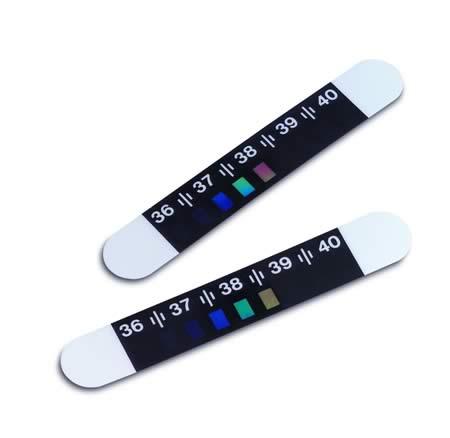
The following video from Medtekhnika+ talks about the types of thermometers.
Methods for measuring body temperature in a child
There are several ways to measure body temperature in children of different ages.
There are usually four of them:
- Axillary. It is measured in the armpit or inguinal fold with a regular mercury thermometer; you can also use an electronic one.
- Oral. In this case, the thermometer is placed in the mouth. It is better to use an electronic thermometer (pacifier thermometer).
- Tympanic. A method for measuring temperature in a child's ear.
- Rectal. The thermometer is inserted into the rectum.
For young children - up to one year - the device and method of measurement are chosen according to practicality. A pacifier thermometer is well suited for measuring a baby's temperature. If the baby does not take the pacifier, purchase an infrared device.
In the armpit
The correct way to measure the temperature in the armpit is as follows:
- The child is placed in his arms or placed on his back (if he does not yet know how to sit).
- The thermometer is placed under the arm so that the tip tightly touches the body, free of clothing.
- Wait for the beep (electronic) or seven minutes (mercury).
In the rectum
The algorithm is as follows:
- The infant is placed on his back, his legs are raised and his knees are slightly bent.
- The tip of the device is lubricated with cream or Vaseline.
- The thermometer is inserted into the rectum no more than one and a half to two centimeters.
- Remove the thermometer also carefully.
When measuring your temperature rectally, always disinfect the thermometer.
In the ear
Only a special apparatus is suitable for this method.
The sequence is:
- The child is placed on his side and they try to straighten the ear canal.
- The thermometer probe is placed in the ear canal.
- Carefully remove the device from the ear.
Techniques for measuring body temperature in children of different ages
Manipulation - Technique for measuring the body temperature of children of different ages, graphic registration. Purpose: diagnostic. Indications: doctor's orders. Contraindications: the presence of hyperemia and local inflammatory processes in the axillary area. Equipment: medical thermometer in a “clean thermometers” container, temperature log, clock, pen, temperature sheet, tray with disinfectant solution. Technique for measuring children's body temperature, algorithm of action. Preparation for the procedure: 1. Wash and dry your hands, put on gloves and a mask; 2. Take a dry, clean thermometer from the container and shake it, make sure that the mercury has dropped below 1 degree; 3. Explain to the patient the purpose and outcome of the procedure; 4. Examine the patient's axillary area; ATTENTION! In the presence of hyperemia or local inflammatory processes, temperature measurements in this area cannot be taken. 5. Wipe the patient's armpit dry; 6. Place the thermometer reservoir in the armpit so that it is in contact with the skin, press the patient's shoulder to the chest, check the position of the thermometer by running the hand along the back edge of the armpit; 7. Hold the hand of children and weakened patients; 8. Remove the thermometer after 10 minutes and determine its readings; End of procedure: 9. Record the thermometer readings in a temperature log. Infection control: 1. Shake the thermometer and immerse it in disinfectant. solution (3% chloramine solution for 5 minutes, 1% chloramine solution for | minutes, 0.5% chloramine solution for 30 minutes) - rinse the thermometer under running water; - wipe dry, place in a marked container at the bottom; - where the napkin lies; 2. Place gloves in a 3% chloramine solution for 60 minutes; 3. Treat your hands at a hygienic level. Note: body temperature in the hospital is measured 2 times a day (from 7 to 9 am and from 17 to 1 pm). Temperature can be measured in the mouth, rectum, and for children in any skin fold. Graphic recording. The temperature measurement results are transferred to a temperature sheet, where, in addition to the graphical recording of temperature measurement data ("T" scale), there are curves of pulse rate ("P" scale) and blood pressure ("BP" scale). To correctly write temperature measurement data, you should remember that the “price” of one division on the “T” scale of the temperature sheet is 0.2 degrees. The column “Day of hospital stay” is divided into 2 halves: “U” (morning) and “B” (evening). Morning temperature is recorded (in black or blue ink) in column “U”, evening temperature - “B”. When connecting the points, a temperature curve is obtained - a graph of temperature changes that reflects a certain type of temperature curve, which has diagnostic value for some diseases.
You might be interested in:
- DTP vaccination technique
- Technique for vaccination against polio
- Urine collection in infants
- Technique for supplying oxygen to a child using the Bobrov apparatus
- Technique for taking scrapings for enterobiasis
We recommend reading:
- Technique for placing a warm compress on a child’s ear
- Technique for placing mustard plasters on children and mustard wrapping
- Hygienic bath technique
- Techniques for performing therapeutic massage and gymnastics for an infant
- Technique for toileting the umbilical wound for omphalitis in newborns

